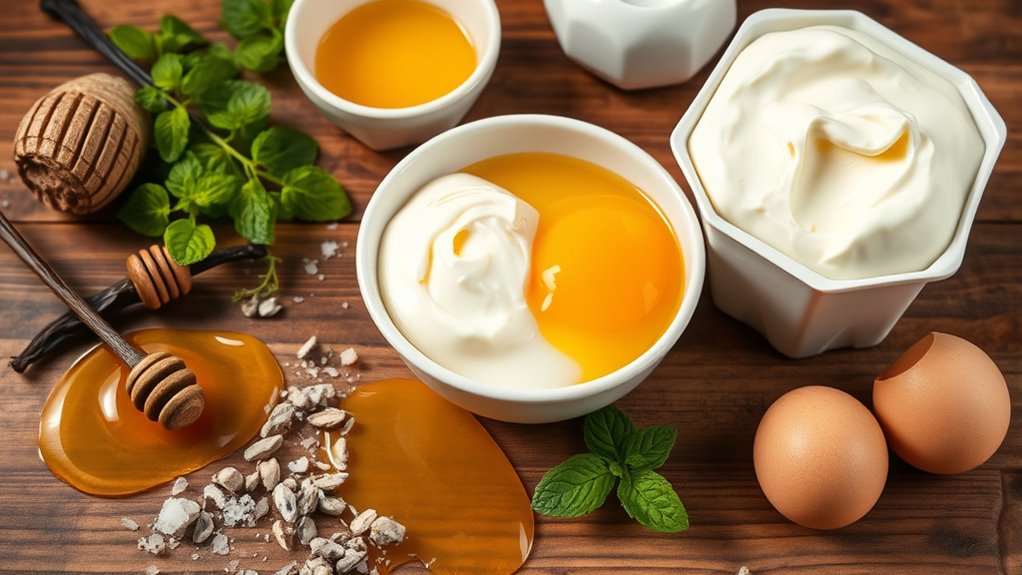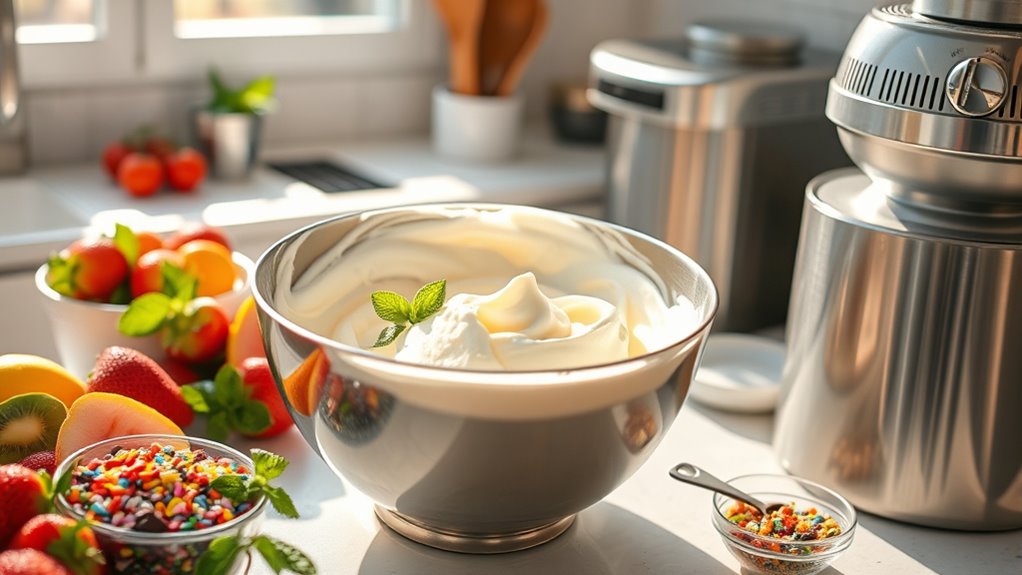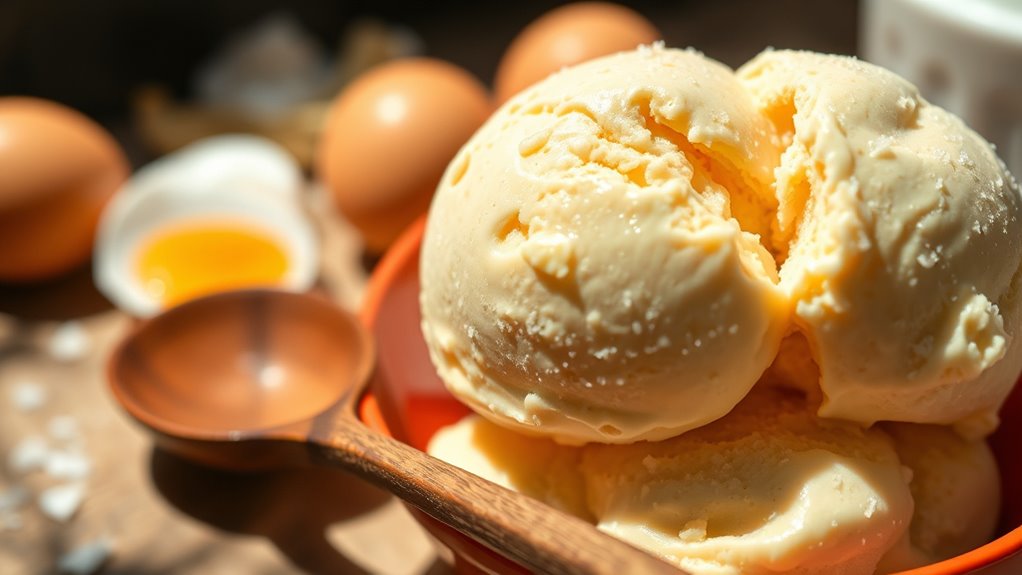To make animal-based ice cream, start with a dairy base of cream, milk, and sugar, along with egg yolks and a pinch of salt. Temper the yolks into the warm dairy, then cook gently to form a smooth emulsion. Chill promptly, then churn until thick and scoopable. Guarantee steady whisking, precise temperatures, and clean equipment. Present with calm, even scoops and complementary toppings. If you keep following, you’ll uncover more precise steps and flavor options.
Ingredients and Quantity

Here are the ingredients and quantities needed for the animal-based ice cream: you’ll gather precise components, weigh them, and proceed with confidence. You control each variable, sourcing from careful ingredient sources to guarantee purity, texture, and flavor potential. Label quantities clearly and keep a prepared workspace to minimize delays. The core items balance fat, sugar, and dairy: cream, milk, sugar, egg yolks, and salt. Flavor variations come later, but today you set the baseline with exact amounts. Use the table to organize inputs and avoid overrun.
| Ingredient | Quantity |
|---|---|
| Cream | 2 cups |
| Milk | 1 cup |
| Sugar | 3/4 cup |
| Egg yolks | 4 |
Preparations

To move from the ingredient setup to preparation, you’ll start by assembling and tempering the dairy base with precision. You’ll measure and preheat, then temper to avoid curdling, maintaining a smooth texture. Next, you’ll heat gently, monitoring temperature with a thermometer for consistent viscosity. Keep agitation steady to prevent skin formation and guarantee even heat distribution. You’ll incorporate flavorings briefly, then chill the base promptly, reducing thermal variation before churning. Safety precautions are essential: sanitize surfaces, wash hands, and avoid cross-contamination with raw ingredients. Equipment needed includes a reliable thermometer, a heavy saucepan, a whisk, an ice bath, and a mixer or churn. Record temperatures and timings, maintaining a disciplined workflow so the base progresses deterministically from liquid to stable, foldable mix ready for freezing.
How to Cook

- Temper the dairy base properly before cooking.
- Warm the base to the target temperature using steady, medium heat.
- Use a gentle whisk to prevent scorching.
- Maintain a calm tempo and monitor the temperature precisely.
- Avoid over-agitation to prevent introducing air.
- As you approach the target temperature, switch to slow, continuous stirring.
- Ensure the mixture forms a smooth, cohesive emulsion.
- When the base coats the back of your spoon, remove it from heat.
- Proceed promptly with the next step.
- Emphasize cooking techniques that protect texture and mouthfeel.
- Consider ingredient substitutions to tailor flavor and consistency (e.g., swap cream for a lighter alternative or adjust sweeteners).
- Record any adjustments made.
- Finalize the base before chilling for best results.
- This approach will provide reliability and freedom in your cooking craft.
How to Serve

Serve ice cream with precision: scoop cleanly, letting the spoon glide through the churn to minimize air incorporation and maintain texture. You choose a clean, steady motion, aligning the scoop to the edge of the bowl for uniform portions. Let the surface settle briefly before serving to reduce drips and melt. For serving suggestions, present one large quenelle or multiple smaller scoops on a chilled plate to preserve shape. Pair flavors with complementary toppings, textures, and temperatures to balance richness. Use presentation ideas like contrasting colors, a drizzle of sauce, or a light dusting of garnish to elevate appeal without overpowering dairy notes. Keep portions moderate, and align each plate with the meal’s pace and mood. Serving suggestions, presentation ideas.
Tips

When making animal-based ice cream, prioritize clean technique and consistent timing. You’ll refine texture by chilling bowls and tools, measuring ingredients, and tempering eggs or stabilizers with calm control. Keep your workspace organized to minimize errors, and label batches for quick comparison. Focus on reproducible steps: base preparation, pasteurization if needed, then controlled cooling and freezing. For flavor delivery, plan gentle additions near the end of churning to preserve aroma and avoid ice crystal formation. Track dairy quality, fat content, and sugar type to achieve desired mouthfeel. Flavor combinations, tested in small runs, help you map sweetness balance and aroma thresholds. Be mindful of dietary considerations, labeling allergens and ensuring suitable substitutions when sharing.
Food Value and Benefit
Animal-based ice cream offers a nutrient-rich profile that provides energy and supports overall well-being. This prepared dish contains high-quality protein, calcium, vitamin A, and beneficial fats that contribute to maintaining physical and mental health.
Benefits of eating this recipe include:
- Supports bone health due to high calcium content
- Promotes muscle maintenance with quality protein
- Provides steady energy release for sustained activity
- Enhances satiety, helping to control appetite
- Contributes to mood stability through essential dairy minerals
- Helps maintain electrolyte balance for proper hydration
Key vitamins and minerals in this recipe:
- Calcium
- Vitamin A
- Phosphorus
- Potassium
- Magnesium
Frequently Asked Questions
Can I Substitute Dairy With Non-Dairy Alternatives in This Recipe?
Yep, you can substitute dairy with non-dairy alternatives. You’ll notice dairy alternatives alter texture, so expect flavor adjustments and experiment with thickeners and sugars to preserve creaminess and balance. Freedom-loving cooks tweak until perfect, with precision.
How Long Can Leftovers Be Stored in the Freezer?
Leftovers can be stored in the freezer for about 2 to 3 months. For best texture, use airtight containers, label dates, and leave space for expansion. Follow freezer tips, and monitor for drift in flavor or odor.
Are There Vegan Options for Animal-Based Ingredients in This Recipe?
Yes, you can use vegan substitutes and plant based options. You’ll swap dairy with coconut, almond, or oat milks, plus vegan fats and stabilizers. Precision: measure, mix, churn, and taste until it matches your freedom-loving standards.
What if I Don’T Have an Ice Cream Maker, Any Substitutes?
Creamy chaos: you can freeze-and-stir, using whisking, periodic scraping, or a no-churn blend. Alternative methods and Freezer techniques achieve texture; you’ll still enjoy smooth scoops without an ice cream maker, plus freedom to improvise delightfully.
Can This Recipe Be Made Lactose-Free Without Altering Flavor?
Yes, you can, lactose-free. Use lactose-free dairy or substitute with coconut milk, add sugar and stabilizers. You’ll preserve flavor by choosing mild bases and sneaking in vanilla; guarantee lactose free alternatives, flavor preservation remain intact.
